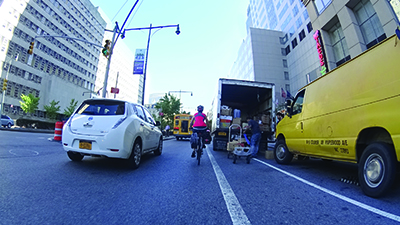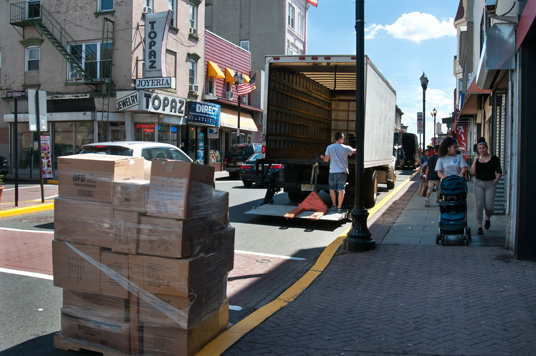Factoring Freight into Complete Streets Plans
Goods movement industry wants a seat at the table

WNYC
A delivery truck blocks a bicycle lane in New York City.
A delivery man pulled and pushed for min-utes on end but couldn’t get his hand truck over the extra high curb. Upon one last try, the frustrated worker’s shipment—a heavy keg of beer—tipped over and rolled into the downtown Washington, D.C., roadway.
At a restaurant across the street, Tom Madrecki watched the episode unfold and considered all of the potential ramifications—safety issues, damaged goods, traffic holdups—which could have been avoided if the curb were a few inches shorter.
American planners spend countless hours mulling how to solve the last-mile question in their cities. But Madrecki’s employer, the world’s largest shipping company, the United Parcel Service (UPS), is concerned above all with the last 50 feet.
“It’s that last 50 feet of the trip where so much can happen, and a lot of things taking place on the city’s side are impacting UPS,” Madrecki, a spokesman for the company, said.
The goal of complete streets policies and improvements is to make streets accessible for all users. In practice, it usually means making car-oriented roads safer for bicyclists and pedestrians. However, complete streets design changes — such as narrower roads and bike lanes—are often the exact opposite of what makes life easier for a truck driver.
Opposing market forces are making the conflicts more pronounced. On one hand, real estate trends nationwide have swung in favor of living spaces in urban cores or downtown areas where residents can walk to stores, restaurants and nightlife. At the same time, the e-commerce revolution has put retail spaces out of business and brought about a surge in deliveries to dense neighborhoods that was never planned for.
How big? According to Alison Conway, a freight policy and logistics expert with the Department of Civil Engineering at the City College of New York, recent research in Fort Lee, New Jersey, found that each residence received about 1.5 packages per week. That means the town’s high-rise apartment buildings overlooking the Manhattan skyline can generate in the neighborhood of 2,000-3,000 deliveries per week.
That said, goods movement experts from around the country say that freight and complete streets are more than compatible. They offered the following food for thought for planners and policymakers as they craft complete streets policies and gear up for road improvement projects.
Engage the Freight Community
Including representatives from the freight community in conversations sounds simple, yet several experts said stakeholder engagement doesn’t include freight enough, and often not at all. As a result, the needs of delivery drivers are not well reflected in complete streets projects and policies.
“The issue, from what I can tell, is that a lot of people who are designing complete streets don’t know what a truck is,” said Darrin Roth, vice president of highway policy for the American Trucking Associations (ATA). “Deliveries are an afterthought.”
Roth urges practitioners to “go to the source” and make sure they consult the industry before making changes that will impact it. The ATA has affiliations in all 50 states and is happy to get involved, he said.
Zack Martin, engineering manager at MacKay Sposito, a land and public infrastructure consulting firm in Vancouver, Washington, recently worked on a blog series dedicated to improving complete streets and freight compatibility. One of its key points was that freight is often left out of the policymaking process.
“If you were to look through a lot of complete streets documents out there and search for the word freight, I’ll bet a lot of them wouldn’t even mention it. That needs to change,” Martin said.
While it’s easy to point the finger at cities for not doing enough to contact freight representatives, he said that in fairness, they are by nature a difficult group to engage.
“These are folks who are passing through your city, so it’s a challenge to even get to them,” Martin said. “It may not be for a lack of trying.”
Freight Friendly Infrastructure and Design
There are any number of infrastructure improvements, big and small, that can help smooth deliveries in cities and downtowns. By consulting a trucking expert during the design stage, officials could hear ideas for even minor tweaks that can make a big difference, Roth said.
For example, he recalled a city installing bike lanes that didn’t leave ample room for a standard box truck to make deliveries, leaving drivers with two choices: park in the loading zone and encroach in the bike right of way or double-park in the road and hurry with the delivery. Either one is a ticketable offense.
Road design trends are also proving challenging. The federal government is encouraging the use of modern roundabouts, circular intersections—much smaller that older traffic circles—as a way to slow speeding vehicles and reduce conflicts at high-crash intersections.
“Roundabouts are all of a sudden the design concept du jour, but they’re very tough for trucks,” Roth said. “However, they can be designed to accommodate trucks. Maybe you’ll need to make them a little wider than you wanted, but if you don’t you’ll wind up needing to repair them anyway because the curbs will get run over.”
Among the simple changes that were suggested were mountable curbs at intersections that won’t harm vehicles if they’re run over; mirrors in loading zones that can help drivers see blind spots; and moving the stop bar at marked intersections back to allow for a wider turning radius.
Loading Zone Reform

Bill Wittkop
A truck driver parks in a bus stop in Union City, New Jersey. Loading zones are one of the most effective tools for helping freight co-exist with dense neighborhoods. However, Madrecki said they are scarce, poorly managed and not seriously enforced in many locations.
UPS has been encouraging cities to allow longer parking times in loading zones so deliverers can return to their vehicles and walk their packages around the area, he said. They also advocate for an increase in delivery spaces in front of stores. Both changes can keep trucks off the road and alleviate safety issues, he said.
Cities should also tighten their rules as to who is allowed to use loading zones and enforce them more strictly, he said. It’s a common complaint among drivers that they have to compete for these spaces with those who shouldn’t be occupying them, like contractors servicing a building, police or regular mail carriers.
“The [postal service] can’t be ticketed [for illegal parking],” Madrecki said. “Well, they can, but they have no obligation to pay. UPS and FedEx are held responsible.”
Conway, from City College of New York, is conducting a study of how 11 U.S. cities are handling complete streets and freight compatibility and has also found that loading zones are a problem in some. Meanwhile, other cities have increased pressure on freight by trying to reclaim the alleys between buildings for other purposes.
New York City’s off-hour deliveries pilot program in 2010 found trucks could make more deliveries in the same amount of time, because they were being made when there was more available parking and less traffic. The city is working to expand business participation in the program.
Conway said off-hour deliveries is one effective strategy cities can implement.
Freight Education
At least some of the difficulties with moving goods in complete streets settings can be traced to the classroom, according to Anne Goodchild, director of the University of Washington’s Supply Chain Transportation and Logistics Center. She observed that planning curriculums tend to treat freight as “a side piece” and devote little time to it.
As a result, there is often a knowledge gap among staff in government planning offices, from small towns all the way up to state departments of transportation.
“Many DOTs have added a freight office, and that’s better than nothing,” Goodchild said. “But often that job is about educating people about freight.”
Goodchild said she would like to see universities offer more freight-related courses as part of their programs and degree requirements.
Do a Corridor Study
One challenge for truckers is that the routes they travel can instantly transform from freeways to main streets. U.S. highways like the famed Route 66 in the Midwest or Route 1 on the East Coast wind through America’s cities, suburbs, industrial meccas and rural landscapes. And in waterfront cities, trucks can leave port areas custom made for big rigs and cut through dense street life on their way to the interstates.
Martin points to the corridor study as an effective tool for dealing with such situations.
“Corridor studies look at the system as a whole,” Martin said. “These are problems that can’t be solved with just one project. It takes a series of projects tied together well.”
A corridor study can explore all of the factors causing congestion or bicycle and pedestrian-freight conflicts and identify simple design policies or major projects, like the creation of a bypass route.
Take an Individual Approach
While experts offer an array of solutions, they also caution that all neighborhoods’ problems must be attacked individually.
“There’s no one-size fits all solution,” Madrecki said. “There’s no, these are the top five things you can do, because every city is entirely different.”
Policymakers should avoid any actions that will tear apart the fabric of what makes places great to satisfy any one user’s needs.
“We want to take each place for the characteristics that we like,” Goodchild said. “New York is a dense, vibrant city with great restaurants and street life. …We don’t want to change it to be more like Houston so it can accommodate trucks.”
Karl Vilacoba is a freelance writer based in New Jersey.